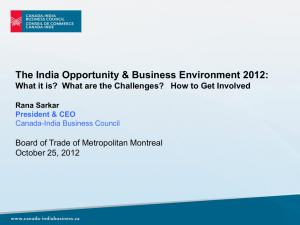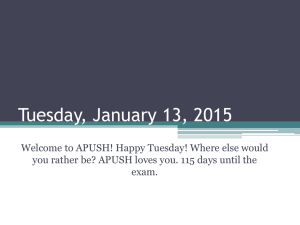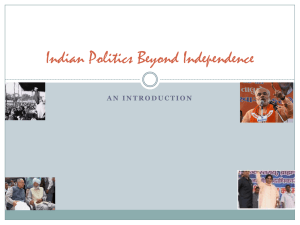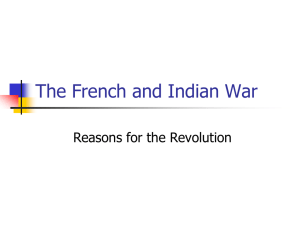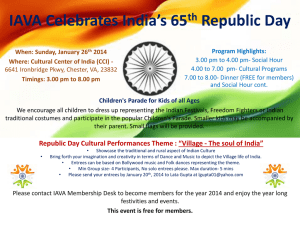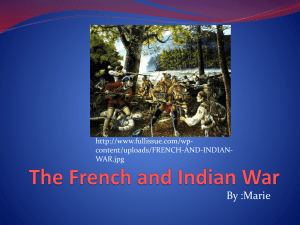Focus_on_India
advertisement
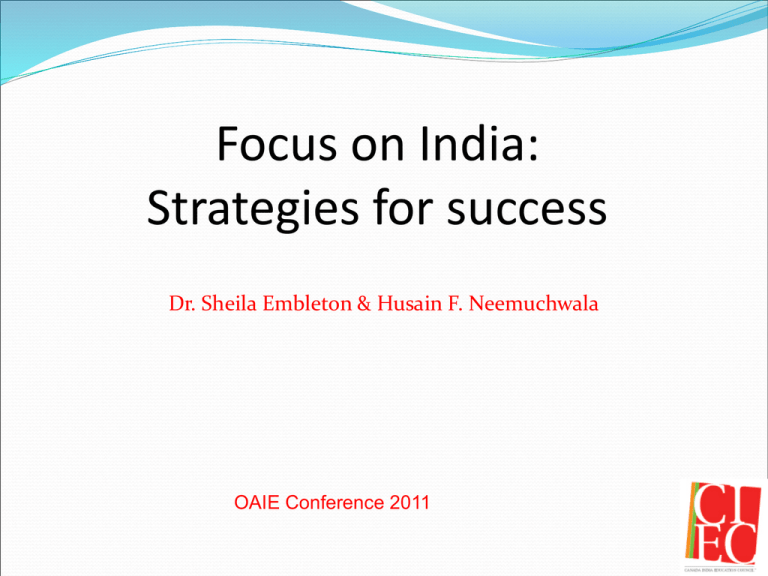
Focus on India: Strategies for success Dr. Sheila Embleton & Husain F. Neemuchwala OAIE Conference 2011 Overview... 1. Present Status: Abundant Unrealized Potential 2. Country-Specific Strategy: Critical for ‘Internationalization’ success 3. Bill 57 & winning conditions: Potentials and many expectations India: Education Market Overview India's education system is among the largest in the world 3rd largest higher education institutions (> 18000) 3rd largest in terms of student enrolment -12.8 million (after US & China) Education market worth US$50 billion- higher and professional education segment constitutes 40% of this market Unprecedented growth in the past decade India: Education Market Overview Gross enrolment ratio remains very low (12% or less than ½ of world average) Few globally recognized Institutions (IIT, IIM…) A sizeable number of Indian students go overseas for higher education Education spending going up significantly, especially for infrastructure development Educational reforms underway –aimed at creating a governance structure that can support the transformation process India: Quick statistics Population 1.3 Billion, 1/3rd below age 30 and growing middle class of 300 Million Over 100,000 Indians go overseas to study every year 18,064 Colleges |379 Universities Only 1 University (JNU-183rd ) & 2 Institutions (IIT’s57th and IIM’s-68th) are in Top 200. Need for quality education ! Huge potential exists! Indian Economy galloping at 9 % International education in India (then) International study inaccessible to the Indian masses Canadian classrooms hosted handful of Indian students (either brightest or richest) Little interest from Canadian institutions in engaging India & faculty exchanges with 1 or 2 institutions or paper agreements High motivation for Indians to aspire for Canada Better academic opportunities and quality of life in Canada and very few thought of returning International education in India (now) Huge, prosperous middle class Fills PSE demand and supply gap in India Better research opportunities in Canada International links provide valued competitive edge to the Indian institution Fulfills the need of a skilled workforce for Indian industry Improved quality of life in India; many Indian students choose to return Understanding trends Bill 57 (challenges & merits) MOU in academic relations between Canada & India... Uptake in Indian students resulting from increased marketing efforts by Canada & issues faced in other countries... 2011 being celebrated as year of India in Canada with Academic delegations, IIFA [Film Academy] awards, several artists | performers and PBD [Overseas Indians] in June Top 10 Countries of Origin of Foreign Students in Canada Flow Stock Flow of All Foreign Students into Canada for 2009 (Total: 85,131) China, 16,369, 19% Rest of the w orld, 26,741, 32% Korea (South), 11,045, 13% Brazil, 1,734, 2% India , 5,716, 7% Germany, 2,330, 3% Mexico , 2,758, 3% Japan , 3,316, 4% France , 5,316, 6% U.S.A, 4,514, 5% Saudi Arabia, 5,292, 6% Foreign Student Presented in Canada on Dec 1st, 2009 (Tota: 196,227*) China , 49,909, 25% Rest of the w orld, 63,598, 33% Korea (South), 25,882, 13% Taiw an, 3,701, 2% Mexico , 4,071, 2% Hong Kong, 4,095, 2% Japan , 6,104, 3% U.S.A, 11,255, 6% Saudi Arabia, 8,750, 4% India , 9,575, 5% France , 9,287, 5% Source: Citizenship and Immigration Canada Annual Flow of Indian Students to Canada (1980-2009) 7,000 6,000 5,000 4,000 3,000 2,000 1,000 20 08 20 06 20 04 20 02 20 00 19 98 19 96 19 94 19 92 19 90 19 88 19 86 19 84 19 82 19 80 0 Source: Entries of students with Indian Citizenship Secured from CIC communication dated Sept. 17, 2010 Canada-India Student Mobility Stock and Flows (1999-2009) 12,000 7000 6000 10,000 Stock Flow 5000 8,000 4000 6,000 3000 4,000 2000 2,000 1000 0 0 1999 2000 2001 2002 2003 2004 2005 2006 2007 2008 2009 Source: Citizenship and Immigration Canada Facts and Figures 2008 and Preliminary 2009 Data 2. Country-Specific Strategy: Critical for Internationalization success • • • • • Operating below optimal potential India now ranks 3rd (after China and South Korea) in terms of annual flow and 4th (after China, Korea and U.S.A) in terms of stock Canada less known ‘brand’ in India. Need quantum leap Areas of collaboration besides recruiting include academia-industry cooperation, alumni networks… Review & re-engage this ‘dynamic’ education corridor Internationalization Financial Reputation Brings international dimension to domestic students on campus Academic experience of graduate students Outbound opportunities for domestic students National interest (immigrants, world knowledge) Development/foreign aid/altruism Travel A quantum leap required in promoting ‘brand Canada’ Need to increase our promotional efforts compared to competitors from other countries Imperative in the light of new developments in India and a better reflection of ALL our Institutions. No co-relation between economic benefits ($6.5B) and our budget in terms of ‘brand promotion’ (roughly $1M) Inexpensive ‘marketing’ options Pre-planned school drop in visits (engage | reward HS Counsellors, student interaction) Pre-planned Alumni networking receptions (makes $$ sense to maintain up to date database) Combined approach (agents?, ‘rep office’?, fairs?,) Reach out using social networking tools (students ‘meeting ground’...FB, Orkut, Ishtyle & many more) ‘Opening’ of India’s doors India’s intention to become “the hub of knowledge in the world” by using “education diplomacy” ...Prof. Balbir Sahni Foreign Education Providers Bill “Under the bill, foreign education-providers will be allowed to operate in India but not allowed to repatriate any profits” Right to Education Act “Education is the birthright of every child in India” Highlighting recent developments India-US Education Council India-Australia Education Council Singapore-India Education Council Creation of the Canada-India Education Council Other countries lining up... 3. Bill 57 & winning conditions: Potentials and expectations Briefly speaking, Bill 57 is a positive development aimed at fostering cross-border education : Targeting minimization of gaps in the present education infrastructure in India; Realizing effective quality-based educational partnership within an open and liberalized regime; Weeding out inappropriate and largely commercial endeavors by foreign educational providers. Key Features of the Bill Government permission and notification mandatory for foreign educational institutions for offering education services in India awarding degrees/diplomas/certificates… Education can be offered through conventional method (including classroom teaching method but excluding distance mode) only, independently or in collaboration, partnership or in a twinning arrangement. FEIs with a standing of at least 20 years only eligible to apply Key Features of the Bill UGC (or its successor) will act as the go to agency for the approval | notification process. The provisions of the UGC Act 1956 will apply to FEIs as they apply to any other university in India. Programs offered in India ought to be consistent with the programs offered in home country in terms of quality and content. Undertaking to maintain a corpus fund of INR 500 million (C$11.34 million) aka=collateral. Time-bound approval process (can take up to 1 yr) Key Features of the Bill Income generated from corpus can be ploughed back for development purposes (up to 75%) and remainder to be deposited with the corpus. NO repatriation allowed ! Penal clauses on default (deposit money can be forfeited) & existing FEIs also required to seek approval under the provisions of the new Act. Advisory Board can exempt a foreign institution on the basis of reputation from the above requirements (with a few exceptions). Educational Institution in India –Possible Entity Structures Alternatives available to set up a Foreign educational institution Society Regulated by Society Registration Act,1860 Minimum number of members required = 7 Main instrument of any society is the memorandum of association and rules and regulations Profits cannot be taken out of the institution and have to be reinvested Trust Regulated by Indian Trust Act,1882/ State Trust Act Trust may be created by every person competent to contract Main instrument of any public charitable trust is the trust deed. Application for registration should be made to the official having jurisdiction over the region in which the trust is sought to be registered Reserve Bank of India approval would have to be obtained to allow non residents/ foreign citizens as trustees Not for Profit Company/ Section 25 Company Governed by Indian Companies Act,1956 Main instrument is a Memorandum and Articles of Association The profits, if any, or other income must be applied for promoting the objects of the company No dividend pay-out to its members Existing Canada-India ‘partnerships’ 28 and counting known partnerships as of 2008 Many Canadian Colleges & Universities have long standing relations with Indian Institutions JV’s, Joint curriculum delivery, 1+1 arrangements… York leading the way with 1 Indian campus already & another one on the way… Preparing to effectively operate in India Undertake market research & understand your target market Build a network of advisors| supporters in both countries Sensitize yourself and staff to the Indian ‘business culture’ Commit firm resources and develop an India Business Plan Prepare for market visits and select a partner or associate Understand logistics and regulations of engaging Establish risk management mechanisms Courtesy: Marvin Hough, Telfer School of Management, U Ottawa Cultural Factors - Underestimated •Time as rigid & exact •Time as soft and elastic •Focused, concentration on Task •Subject to distractions, interruptions •Sequence talking, turn taking •Overlap talk •Achieved Status •Earned Accomplishment •Shared Authority •Special privilege •Consultation and Teamwork •Direction and Relationships •Tradition is ‘interesting’ •Tradition is critical and valued •Ascribed Status •Clear Authority figures Courtesy: Marvin Hough, Telfer School of Management, U Ottawa What is CIEC ? CIEC is an independent national, not‐for‐profit, membership based, event driven organization established to operate exclusively within the burgeoning Canada‐India education corridor. CIEC’s goal is to enhance ties and create opportunities for academic institutions and learners from both countries. Presence in both countries. 3 Membership categories. Member Services Rep Offices in India (3 cities to begin with) Participation on Ed-Mission, Synergy, unFAIR… Link | exposure on CIEC website One-call access in both countries (dedicated phone #) ‘On the ground’ expertise Receptions, Networking events & Delegations On site visits (at least once per year) Invite or attend ‘Familiarization Tours’ Stay connected electronically (FB, Linked In, Twitter…) CIEC: Executive team • Chairman- Honourable Pierre S Pettigrew, PC Past Federal Trade Minister • Vice-Chair Kam Rathee Past President, C-IBC • President- Prof. Sheila Embleton Past President, Shastri; York University; MITACS • Executive Director & COO- Husain F Neemuchwala Founder-ICE ; Past chair, C-IBC Ed. Committee CIEC’s Upcoming Events in 2011 NAFSA reception, Vancouver, Consulate-General of India in Vancouver, June 2, 2011 Synergy Toronto, October 6-7, 2011 BIG (Business Institutions Government) Mission to India, November 7-17, 2011 Recruiting mission to India (Feb 2012) THANK YOU...

